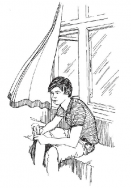27. Shelter and ventilation
27. Shelter and ventilation
Last update: 2023-04-03
Overview
The environment and spaces people spend time in have a large impact on their health and well-being. Many diseases can spread through air or because of water and sanitation conditions.
- Some diseases are spread by droplets in the air (often through coughing and sneezing). Germs can become more concentrated in poorly ventilated rooms or homes in which a sick person is coughing or sneezing. In buildings that are stuffy and poorly ventilated (with little flow of air) a sick person can infect every other person in the same space. To reduce the risk of spreading disease to others, it is a good idea to ventilate houses. People should be instructed to open windows or doors to allow fresh air to come in and stuffy, old air to go out.
- When many people live together in the same space (overcrowding), they can also catch infections more easily from one another. If possible, people should have enough space to move and breathe freely. If possible, encourage people to live or gather in places where there is adequate space.
- In addition to the risk of uncontrolled fires and burns, cooking with charcoal or firewood in an enclosed space (a room or shelter without windows) can harm people who are sick with air-borne diseases. Smoke can make it difficult to breathe, especially if other respiratory conditions are present. It is important to have enough air flow to take the smoke and fumes away.
- Other diseases are spread via contaminated water or bad sanitation or absence of shelter. Diseases that spread via contaminated water or bad sanitation (diarrhoeal diseases, cholera, typhoid, hepatitis E, for example) will spread more easily if clean water is lacking or if sound, clean toilets are not set close to where people shelter. Proper shelters, with clean water and sanitation facilities, which protect people from rain, wind, sun and cold help prevent diseases from spreading and help sick people recover from disease.
What to do and how to do it
Preventing disease in shelters
- When people move following conflict or disaster, the shelters they move into are not usually as good as those they are used to. Help people to have the best possible shelter, one that is well ventilated and has a good water supply, with latrines and waste disposal facilities close by.
- Always ventilate shared or communal shelters and emergency accommodation.
- Advise people to keep their windows open if the weather permits, especially if they are caring for a sick person.
- Encourage people to wash their hands after going to the toilet, after cleaning a child, and before preparing or eating food.
- Encourage people to wash water storage containers regularly with soap and water, and to keep the area around the shelter free from rubbish and animal waste.
Managing disease in shelters
- When an outbreak of air-borne diseases occurs, it is important to tell your community about the importance of good ventilation and encourage them to open windows and doors regularly.
- When a food or water-borne disease outbreak occurs, it is important to tell your community about the importance of food hygiene and safety, as well as the importance of access to clean water and proper sanitation facilities and waste disposal.
Social mobilization, messaging and community engagement
- Talk to the community about the importance of a clean water supply, sanitation, handwashing and good food hygiene. (See Action tools Clean, safe household water, Good food hygiene, Sanitation, Building and maintaining latrines, Handwashing with soap and Handwashing in a highly infectious epidemic).

